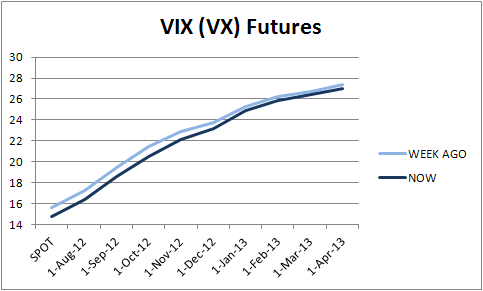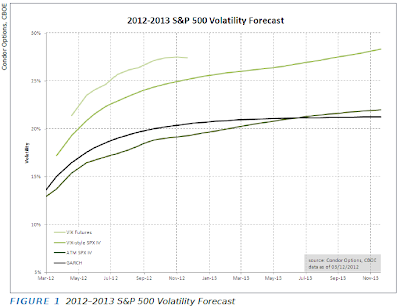In Leveraged ETF and CPPI type Strategy by Bertrand and Prigent I came across an interesting formula: probability of leveraged ETF declining in value while regular fund increases.
Over a period of one day correlation between returns is close to one, but over longer time periods funds usually diverge significantly, that it return of leveraged fund is not leverage times regular funds return. Particularly disappointing situation for leveraged ETF investor is when over some period of time regular ETF increases in value while leveraged ETF declines.
------------------------------------------------
Example 1: consider SSO - ProShares Ultra (leverage_factor=+2) S&P 500 ETF. SPY volatility is about 20%. Expense ratio for SPY is 0.09%, for SPXU 0.91%. I don't know the short rate for SPY but let's assume it is zero. If investor is bullish on the S&P 500 and decided to buy SSO and hold it for 1/2 year, there is 3.31% chance that SSO ill decline even if the investor is correct in the forecast (SPY increases). Even for a relatively short time period on one month such probability is 1.36%.
------------------------------------------------
The formula by Bertrand and Prigent is based on assumption of continuous brownian motion, and is fairly accurate approximation for discrete process. The formula they derived works only for positive leverage, but not for inverse ETFs. I derive formulas for inverse ETFs and also extend their work for different drift conditions, like expense ratios.
The applet below is interactive, but may be a bit slow to update. You can download the spreadsheet on your computer by clicking on Excel button.
Over a period of one day correlation between returns is close to one, but over longer time periods funds usually diverge significantly, that it return of leveraged fund is not leverage times regular funds return. Particularly disappointing situation for leveraged ETF investor is when over some period of time regular ETF increases in value while leveraged ETF declines.
------------------------------------------------
Example 1: consider SSO - ProShares Ultra (leverage_factor=+2) S&P 500 ETF. SPY volatility is about 20%. Expense ratio for SPY is 0.09%, for SPXU 0.91%. I don't know the short rate for SPY but let's assume it is zero. If investor is bullish on the S&P 500 and decided to buy SSO and hold it for 1/2 year, there is 3.31% chance that SSO ill decline even if the investor is correct in the forecast (SPY increases). Even for a relatively short time period on one month such probability is 1.36%.
------------------------------------------------
The formula by Bertrand and Prigent is based on assumption of continuous brownian motion, and is fairly accurate approximation for discrete process. The formula they derived works only for positive leverage, but not for inverse ETFs. I derive formulas for inverse ETFs and also extend their work for different drift conditions, like expense ratios.
The applet below is interactive, but may be a bit slow to update. You can download the spreadsheet on your computer by clicking on Excel button.
Inputs are: leverage factor (negative for inverse ETFs), time in years, volatility of regular ETF (leveraged ETF will have volatility times |leverage|), financing rate, and two drift parameters (for example annual expense ratio of 1% would be -1% drift) Leveraged ETFs usually have higher expense ratios, so I separated the two parameters.
Outputs are: reg pos lev neg - probability that regular ETF will have positive return while leveraged ETF will have a negative return, reg pos lev neg (inv) - same for inverse ETFs, and reg neg lev neg (inv) - probability that both funds decline in value. The reason for two formulas for inverse ETFs is that inverse ETF is "expected" to decline when regular ETF rises in value. Last probability is the disappointing scenario of regular ETF declining, and inverse ETF declining as well.
------------------------------------------------
Example 2: consider SPXU - UltraShort (leverage_factor=-3) S&P 500 ETF. SPY volatility is about 20%. Expense ratio for SPY is 0.09%, for SPXU 0.93%. I don't know the short rate for SPY but let's assume it is zero. If investor is bearish on the S&P 500 and decided to buy SPXU and hold it for 1/2 year, there is 11.77% chance that SPXU will decline even if the investor is correct in the forecast (SPY declines as well). Even for a relatively short time period on one month such probability is non-trivial 4.83%.
------------------------------------------------
Financing cost is the cost to the ETF provider to create leverage - borrow rate for positive leverage ETFs, and short rate for inverse ETFs. I assume that (like in the current environment) one would have to pay both.
cost = IF(leverage_factor>0,rate*(1-leverage_factor)*time,rate*(leverage_factor)*time)
Terms in B9, B10, and B11 are generalized from Bertrand and Prigent's paper. First result is theirs as well, the last two are my contribution.
If you are using the formulas on your blog, website, or research please acknowledge the original source.

































